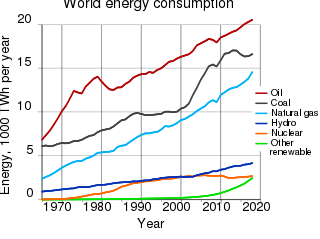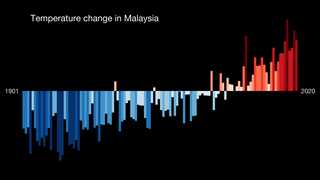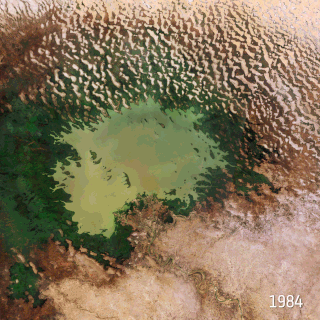
Human impact on the environment refers to changes to biophysical environments and to ecosystems, biodiversity, and natural resources caused directly or indirectly by humans. Modifying the environment to fit the needs of society is causing severe effects including global warming, environmental degradation, mass extinction and biodiversity loss, ecological crisis, and ecological collapse. Some human activities that cause damage to the environment on a global scale include population growth, neoliberal economic policies and rapid economic growth, overconsumption, overexploitation, pollution, and deforestation. Some of the problems, including global warming and biodiversity loss, have been proposed as representing catastrophic risks to the survival of the human species.

African environmental problems are problems caused by the direct and indirect human impacts on the natural environment and affect humans and nearly all forms of life in Africa. Issues include deforestation, soil degradation, air pollution, water pollution, coastal erosion, garbage pollution, climate change, Oil spills, Biodiversity loss, and water scarcity. These issues result in environmental conflict and are connected to broader social struggles for democracy and sovereignty. The scarcity of climate adaptation techniques in Africa makes it the least resilient continent to climate change.
The natural environment, commonly referred to simply as the environment, is all living and non-living things that occur naturally on Earth or some part of it. This includes complete ecological units that function as natural systems without massive human intervention, including all vegetation, animals, microorganisms, rocks, atmosphere and natural phenomena that occur within their boundaries. And it includes universal natural resources and physical phenomena that lack clear-cut boundaries, such as air, water, and climate, as well as energy, radiation, electric charge, and magnetism, not originating from human activity.

A green-collar worker is a worker who is employed in an environmental sector of the economy. Environmental green-collar workers satisfy the demand for green development. Generally, they implement environmentally conscious design, policy, and technology to improve conservation and sustainability. Formal environmental regulations as well as informal social expectations are pushing many firms to seek professionals with expertise with environmental, energy efficiency, and clean renewable energy issues. They often seek to make their output more sustainable, and thus more favorable to public opinion, governmental regulation, and the Earth's ecology.
This page is an index of sustainability articles.
Climate change is having major effects on the Chinese economy, society and the environment. China is the world's largest emitter of carbon dioxide, through an energy infrastructure heavily focused on coal. China's per capita emissions are greater than the world and European Union averages but less than Australia, Canada, and the U.S. China recorded its hottest year on record in 2023, with an average temperature of 10.7 °C. On the basis of cumulative CO2 emissions measured from 1751 through to 2017, China is responsible for 13% of global and about half of the United States' cumulative emissions.
The natural environment, commonly referred to simply as the environment, includes all living and non-living things occurring naturally on Earth.

The environmental impact of the energy industry is significant, as energy and natural resource consumption are closely related. Producing, transporting, or consuming energy all have an environmental impact. Energy has been harnessed by human beings for millennia. Initially it was with the use of fire for light, heat, cooking and for safety, and its use can be traced back at least 1.9 million years. In recent years there has been a trend towards the increased commercialization of various renewable energy sources. Scientific consensus on some of the main human activities that contribute to global warming are considered to be increasing concentrations of greenhouse gases, causing a warming effect, global changes to land surface, such as deforestation, for a warming effect, increasing concentrations of aerosols, mainly for a cooling effect.

The environmental impact of the petroleum industry is extensive and expansive due to petroleum having many uses. Crude oil and natural gas are primary energy and raw material sources that enable numerous aspects of modern daily life and the world economy. Their supply has grown quickly over the last 150 years to meet the demands of the rapidly increasing human population, creativity, knowledge, and consumerism.

The water-energy nexus is the relationship between the water used for energy production, including both electricity and sources of fuel such as oil and natural gas, and the energy consumed to extract, purify, deliver, heat/cool, treat and dispose of water sometimes referred to as the energy intensity (EI). Energy is needed in every stage of the water cycle from producing, moving, treating and heating water to collecting and treating wastewater. The relationship is not truly a closed loop as the water used for energy production need not be the same water that is processed using that energy, but all forms of energy production require some input of water making the relationship inextricable.
Energy in the Middle East describes energy and electricity production, consumption and import in the Middle East. Energy policy of the Middle East will describe the politics of the Middle East related to energy more in detail.

Environmental issues in the United Arab Emirates (UAE) are caused by the exploitation of natural resources, rapid population growth, and high energy demand. The continuing temperature rise caused by global warming contributes to UAE's water scarcity, drought, rising sea level, and aridity. The UAE has a hot desert climate, which is very vulnerable to the effects of climate change and contributes to worsening water scarcity, quality, and water contamination.

Climate change is having a considerable impact in Malaysia. Increasing temperatures are likely to greatly increase the number of heatwaves occurring annually. Variations in precipitation may increase the frequency of droughts and floods in various local areas. Sea level rise may inundate some coastal areas. These impacts are expected to have numerous environmental and socioeconomic effects, exacerbating existing environmental issues and reinforcing inequality.

Climate change in the Middle East and North Africa (MENA) refers to changes in the climate of the MENA region and the subsequent response, adaption and mitigation strategies of countries in the region. In 2018, the MENA region emitted 3.2 billion tonnes of carbon dioxide and produced 8.7% of global greenhouse gas emissions (GHG) despite making up only 6% of the global population. These emissions are mostly from the energy sector, an integral component of many Middle Eastern and North African economies due to the extensive oil and natural gas reserves that are found within the region. The region of Middle East is one of the most vulnerable to climate change. The impacts include increase in drought conditions, aridity, heatwaves and sea level rise.

Climate Change in Nigeria is evident from temperature increase, rainfall variability. It is also reflected in drought, desertification, rising sea levels, erosion, floods, thunderstorms, bush fires, landslides, land degradation, more frequent, extreme weather conditions and loss of biodiversity. All of which continue to negatively affect human and animal life and also the ecosystems in Nigeria. Although, depending on the location, regions experience climate change with significant higher temperatures during the dry seasons while rainfalls during rainy seasons help keep the temperature at milder levels. The Effects of Climate Change prompted the World Meteorological Organization, in its 40th Executive Council 1988, to establish a new international scientific assessment panel to be called the International Panel on Climate Change (IPCC). The 2007 IPCC's fourth and final Assessment Report (AR4) revealed that there is a considerable threat of Climate Change that requires urgent global attention. The report further attributed the present global warming to largely anthropogenic practices. The Earth is almost at a point of no return as it faces environmental threats which include atmospheric and marine pollution, global warming, ozone depletion, the dangers of pollution by nuclear and other hazardous substances, and the extinction of various wildlife species.

Israel, like many other countries in the Middle East and North Africa, experiences adverse effects from climate change. Annual and mean temperatures are increasing in Israel, with mean temperature expected to increase between 1.6 and 1.8 °C by 2100. There is a reduction in annual precipitation and delayed winter rains. Israel is already experiencing droughts and water shortages. Heatwaves are other natural hazards expected to increase with climate change.

Kuwait, located in the Arabian Peninsula of the Middle East and North Africa region, has a total area of 17,818 km2. The country consists primarily of arid desert environments, coastal areas, and some wetlands. Kuwait has some of the driest and warmest summers with average temperatures falling at around 46.2 degrees Celsius. Kuwait is highly vulnerable to climate change impacts, which pose many risks to the country's infrastructure, ecosystems, water resources and agricultural development. Kuwait has implemented several mitigation and adaptation strategies and is part of the NATO-Istanbul Cooperation Initiative (ICI) that looks to address climate risks and engage in sustainable solutions.

Climate change is having significant and diverse impacts, like higher temperatures, lower precipitation and sea level rise on Saudi Arabia's environment, society and economy. agricultural, fishing and tourism industries. Saudi Arabia is the fourth largest consumer of oil in the world, even as it is the 20th largest economy and 41st largest population.

The United Arab Emirates (UAE) faces the impacts of climate change such as water stress, rising sea levels, dust storms, desertification and extreme heat. Climate change threatens the country's water resources, wetland ecosystems, human health, economic stability, and international affairs. The UAE has a hot desert climate and is located on the coast of the Persian Gulf and the Gulf of Oman. Decreasing annual precipitation levels and increased desertification make the country's rural and urban populations vulnerable. Climate change is projected to increase national vulnerabilities in the United Arab Emirates. Sea level rise is expected to impact the UAE's urban infrastructure and marine and wetland ecosystems. The agricultural, fishery, and tourism sectors in the UAE are at risk due to the negative effects of climate change.




















